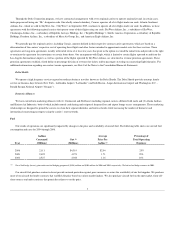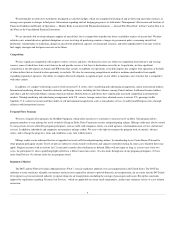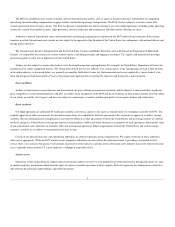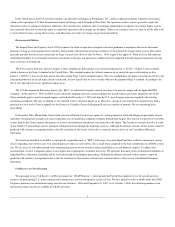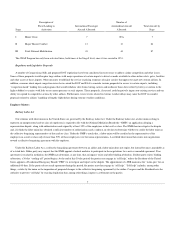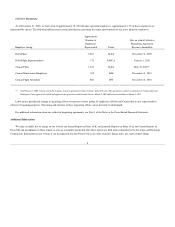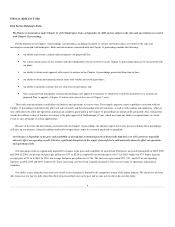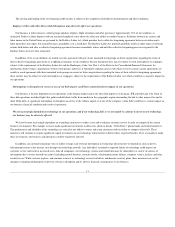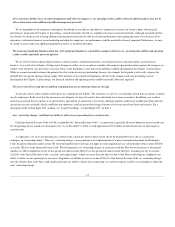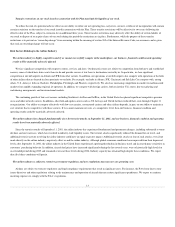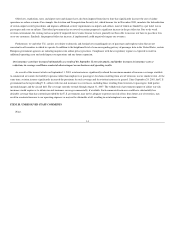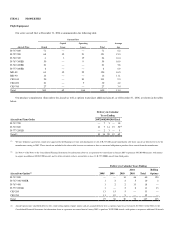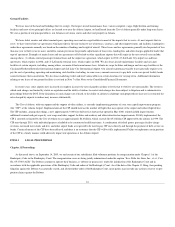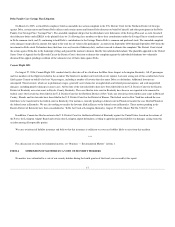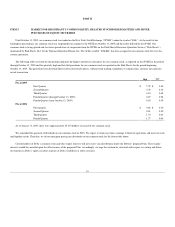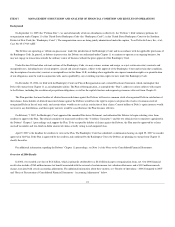Delta Airlines 2006 Annual Report Download - page 18
Download and view the complete annual report
Please find page 18 of the 2006 Delta Airlines annual report below. You can navigate through the pages in the report by either clicking on the pages listed below, or by using the keyword search tool below to find specific information within the annual report.
Transfer restrictions on our stock issued in connection with the Plan may limit the liquidity of our stock.
To reduce the risk of a potential adverse effect on our ability to utilize our net operating loss carryovers, our new certificate of incorporation will contain
certain restrictions on the transfer of our stock issued in connection with the Plan. These transfer restrictions will be effective for two years following the
effective date of the Plan, subject to extension for an additional three years. These transfer restrictions may adversely affect the ability of certain holders of
our stock to dispose of or acquire shares of our stock during the period the restrictions are in place. Furthermore, while the purpose of these transfer
restrictions is to prevent an “ownership change” from occurring within the meaning of section 382 of the Internal Revenue Code, no assurance can be given
that such an ownership change will not occur.
Risk Factors Relating to the Airline Industry
The airline industry is highly competitive and, if we cannot successfully compete in the marketplace, our business, financial condition and operating
results will be materially adversely affected.
We face significant competition with respect to routes, services and fares. Our domestic routes are subject to competition from both new and established
carriers, some of which have lower costs than we do and provide service at low fares to destinations served by us. In particular, we face significant
competition at our hub airports in Atlanta and JFK from other carriers. In addition, our operations at our hub airports also compete with operations at the hubs
of other airlines that are located in close proximity to our hubs. For example, our hubs in Atlanta, JFK, Cincinnati and Salt Lake City compete with, among
others, U.S. Airways’ hubs in Charlotte, Philadelphia, Pittsburgh, and Phoenix, respectively. We also face increasing competition in smaller to medium-sized
markets from rapidly expanding regional jet operators. In addition, we compete with foreign carriers, both on interior U.S. routes, due to marketing and
codesharing arrangements, and in international markets.
The continuing growth of low-cost carriers, including Southwest, AirTran and JetBlue, in the United States has placed significant competitive pressure
on us and other network carriers. In addition, other hub-and-spoke carriers such as US Airways and United Airlines reduced their costs through Chapter 11
reorganizations. Our ability to compete effectively with low-cost carriers, restructured carriers and other airlines depends, in part, on our ability to maintain a
cost structure that is competitive with those carriers. If we cannot maintain our costs at a competitive level, then our business, financial condition and
operating results could be materially adversely affected.
The airline industry has changed fundamentally since the terrorist attacks on September 11, 2001, and our business, financial condition and operating
results have been materially adversely affected.
Since the terrorist attacks of September 11, 2001, the airline industry has experienced fundamental and permanent changes, including substantial revenue
declines and cost increases, which have resulted in industry-wide liquidity issues. The terrorist attacks significantly reduced the demand for air travel, and
additional terrorist activity involving the airline industry could have an equal or greater impact. Additional terrorist attacks or fear of such attacks, even if not
made directly on the airline industry, negatively affect us and the airline industry. Although global economic conditions have improved from their depressed
levels after September 11, 2001, the airline industry in the United States experienced a prolonged reduction in business travel and increased price sensitivity in
customers’ purchasing behavior. In addition, aircraft fuel prices have increased significantly during the last several years, were at historically high levels for
an extended period during 2005 and remained at or near those levels during 2006. Industry capacity has remained high despite these conditions. We expect
that all of these conditions will persist.
The airline industry is subject to extensive government regulation, and new regulations may increase our operating costs.
Airlines are subject to extensive regulatory and legal compliance requirements that result in significant costs. For instance, the FAA from time to time
issues directives and other regulations relating to the maintenance and operation of aircraft that necessitate significant expenditures. We expect to continue
incurring expenses to comply with the FAA’s regulations.
13


